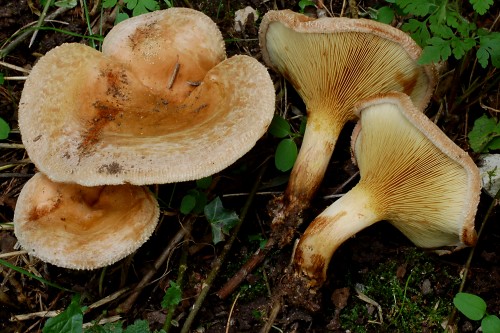Paxillus Fr.
Cap depressed to funnel-shaped, velvety or tomentose, later smooth, cap margin inrolled and remaining so for a long time. Gills forking. Spore print rusty, brownish or vinaceous.
At least eight species are described in Europe. With exception of Paxillus rubicundulus, that is relatively easy to recognize, the rest of the species gravitate closely around Paxillus involutus.
The colour of the spore print is thought to be important for the species recognition, so it should be thoroughly noted when freshly deposited. The crystal that occur in the rhizomorphs are also considered important so any Paxillus collection must contain fruitbodies with preserved basal mycelium.
Reaction with ammonia solution is used to separate some of the species. It has been proven in other bolete genera that the ammonia reaction has little (if any) taxonomic value. However, it has not been evaluated in Paxillus and it should be tested systematically.
Paxillus ammoniavirescens Contu & Dessi
Yet unknown to me. The name refers to the greenish reaction of the cap with ammonia solution. Known from Italy, but collections from under willows (Salix) showing greenish flush with ammonia are mentioned also from the British Isles.
Photographs

Fruitbodies of Paxillus ammoniavirescens. (photo M. Floriani)
Important literature
Dessi, P. & Contu, M. 1998. Paxillus ammoniavirescens sp. nov. with notes on the genus Paxillus (Boletales) in Sardinia. – Micologia e Vegetazione Mediterranea 13(2): 121–130.